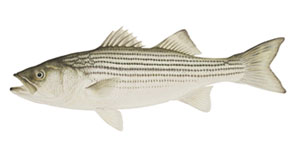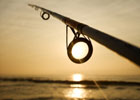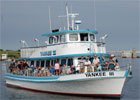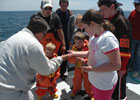Fishing For
Top Sites
 Striped Bass
Striped Bass
Striped bass is a coastal fish species well known to both sport anglers and commercial fishermen along the entire Atlantic coast of the U.S. The striped bass gets its name from the characteristic dark stripes that run horizontally along the fish's sides. Other common names used for striped bass in different regions of the Atlantic coast include rockfish, striper, and roller. Striped bass travel in schools and are most abundant in coastal ocean waters, inshore bays, and coastal rivers. Striped bass are an anadromous fish, which means that the adults migrate from ocean waters into freshwater rivers to reproduce or spawn.
Management of the striped bass fishery has been controversial and quite contentious over much of the past two decades. Studies conducted in the late 1970s and 1980 demonstrated serious declines in striped bass populations from all of the major stocks. Various possible causes for these declines included over fishing by both recreational and commercial fishermen, habitat deterioration, and poor water quality as a result of industrial pollution in spawning areas in the Hudson River and Chesapeake Bay tributaries. As a result, striped bass fishing in New York has been strictly regulated since the early 1980s. Some of these regulations have been the result of management plans designed to allow populations to rebuild and some have been designed to protect people from ingesting PCBs that accumulate in this fish during the time it spends in contaminated freshwater rivers like the Hudson.
Striped bass is a highly prized species both by recreational fishermen who consider it one of the most exciting and challenging fish to catch. Commercial fishermen have engaged in a traditional fishery for this species for many generations. Heated debates and some conflicts between these two user groups have been highly publicized, and both groups have been strictly regulated. The entire commercial harvest of striped bass was closed in New York during the years 1986 through 1989, and recreational fishermen have followed strict limits on the amount, size, and times of the year when fish could be landed. As a result of these management efforts, the Hudson River stock of striped bass is near historic high levels and the Chesapeake stock has begun to rebuild. Current management regulations allow commercial fishing from July 1st to December 15th and fish not less than 24 inches total length or greater than 36 inches total length can be landed. Some types of fishing gear cannot be used, and there is a quota limiting the total amount of fish that can be caught commercially. Fishermen, dealers and shippers all must have a valid permit from the state and all striped bass caught in NY for sale must be tagged. The recreational fishing season is from May 8th to December 15th and the minimum length is 28 inches total length and only one fish can be kept per day.
Because striped bass have a unique life cycle in which they are exposed to and accumulate environmental pollutants such as PCBs, fish consumption advisories have been in effect for this species for over two decades. Current advisories for striped bass taken from Jamaica Bay, Eastern Long Island Sound (East of Wading River), Peconic and Gardiners Bay or Long Island's south shore waters are to eat no more than one meal per week of fish caught in these areas. For striped bass taken from Upper and Lower Bays of New York City Harbor or Long Island Sound west of Wading River, women of childbearing age and children under the age of 15 should eat no striped bass and all other people should limit their consumption of striped bass from these waters to no more than one meal per month. These advisories have been in effect for a number of years and as new evidence has documented a decline in PCB levels the advisories have been relaxed for ocean caught striped bass and may soon be relaxed for the first time in 25 years for fish caught in the Hudson River.
The commercial market for striped bass has fluctuated significantly over the past 15 years. For many years striped bass harvested from the wild were virtually unavailable in the marketplace. Because of the high demand for this species, an aquaculture industry developed to produce a smaller hybrid striped bass, which is a cross between a freshwater bass and striped bass. These hybrid bass have been widely available in seafood markets and restaurants in New York for well over a decade. As management efforts have been successful in rebuilding striped bass populations and PCB levels have declined, wild caught striped bass has become more available in the marketplace and is likely to continue to become more plentiful. New York harvested striped bass is only available from July to December when the commercial fishing season is open. Hybrid striped bass raised by aquaculture are available all year.
Striped bass is a flaky and relatively firm textured fish that has a mild but distinctive flavor that is highly prized. It is unusual in that it can be substituted both for milder tasting fish, like cod, as well as for fish with a stronger flavor like bluefish or weakfish in many recipes. These excellent eating fish are available as fillets, steaks, chunks, or whole. They adapt readily to most preparation methods including baking, broiling, pan-frying oven frying, and poaching. Striped bass also provide one of the few easily grilled fillets, which makes it especially popular in the beach communities.


